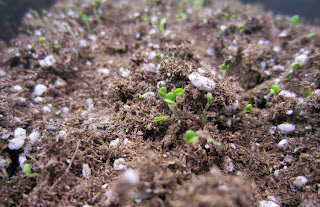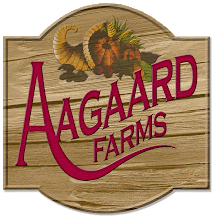 |
| One corner of the root cellar. |
 |
From left: French Fingerling, All Red, Pink Fir Apple,
Russian Blue and Linzer Deleketess. |
Most people know, from the grocery store, that there is a red potato, a white potato and the baking potato. These people are rather surprised when they learn we're growing twenty six varieties of potatoes! When you've got a bit of space and you grow things, it's kind of easy to start collecting interesting seeds of vegetables you really like - and that is certainly what Farmer Man has done with potatoes! He's had helped from a few acquaintances also potato-obsessed: Menno and Greg B. have contributed to our stock of interesting seed potatoes! It also definitely helps that we have a proper root cellar with ample room for storage!
Potatoes are largely classified by when they are ready to harvest: early season, mid and late season. Early season potatoes are the first to be taken as new or baby potatoes - the Spring delicacy we dream about all winter! There's just something extra special about new potatoes: a freshness, a sweetness, it's hard to define but they are a short-lived treat as the potatoes continue to grow and become just regularly, tasty potatoes! It is a timing thing, as well. Small potatoes are not necessarily new potatoes; we can harvest late in the Fall and each plant might have a couple of little spuds but they will not have the taste of a potato dug at the beginning of July! Mid and late season varieties can be taken as new potatoes two to four weeks later, but most of those varieties have thicker skins and deeper eyes and are just not the same as an early. Mid and late season varieties tend to store better; it's mostly late varieties that we're currently eating! Early potatoes, for us, can be mature by the end of August, late season we'll leave until mid to late October.
So here's a wee round up of what's in our root cellar, still being eaten and just waiting to get planted:
EARLY SEASON:
Aladin: A red potato, awesome as a new potato! Mature, it's texture is often described as 'floury' or dry, meaning it's good for mashing, needs extra butter when boiled!
Almera: Medium sized white potatoes, pretty good in storage.
Caribe: Purplish potato that sets lots of spuds! Stores quite well.
Carlton: A lovely white potato, multi-purpose.
Eramosa: Probably our favorite new potato - thin skinned and delicate white potato!
Norland: Awesome red baby potato. I've got to admit to you I wouldn't eat a Norland most of the winter - they become soft and bland quite quickly in storage and there are just better choices.
Warba: Exists in records since 1933. Not available for sale this year, we're still building our stock.
Charlotte: New to us this year, just given to us be Greg B. Very popular in the UK as what they call a 'salad' potato, not a term we use a lot in North America. Apparently, it's somewhat waxy and the skin comes off easily, making it great for potato salad. Not available for sale this year!
MID-SEASON
Alaska Sweetheart: Red on the outside and interesting pink-marbled flesh! Bred in Alaska, good for short season gardens! Similar to All Red, but a smaller potato. Not sure we're going to continue to grow this one because we prefer All Red!
Cherry Red: A smaller potato with a deep red skin. Great all-round potato. Very nice in potato salads if you leave the skin on!
Linzer Deleketess: Ah, one of my favorites! Heirloom fingerling - meaning it grows long and skinny. The fingerlings are mostly all waxy in texture making them awesome for roasting, soups and stews because they hold their shape, they don't get crumbly like a white or mushy like a red. Beautiful, nutty flavor. Stores awesome for a mid-season! Maybe we'll have some for dinner tonight!
Purple Viking: Lovely, large multi-purpose, purple skinned, white fleshed potato. Good baked, boiled, mashed, nice creamy texture!
Roko: A good red, quite nice as a new potato a couple of weeks after you've eaten the Norland!
Sangre: Probably our favorite red for eating all winter! Crisp flesh makes a lovely creamy texture, great flavor, stores well. With last year's high water table, for the first time ever we've had a wee problem with hollow interiors in the large potatoes.
Yukon Gold: A golden fleshed, golden skinned potato, good flavor, great for fries. Consistently picked by top chefs as one of the best flavored potatoes out there, used to be one of my favorites until I met German Butterball!
Marc Warshaw's Quebec - New to us, acquired through Menno. A really funky potato with a marbled red and white skin. The story seems to be that a fellow named Marc Warshaw scored some seed from an elderly Quebec farmer who's family had been growing it for years. Seed of Diversity lists it as one of their members' favorite potatoes! Not available this year as we'll be trying to increase our stock.
Tamagami: Another selection via Menno. Apparently a red like Chieftain, but better. Not available this year.
LATE SEASON
All Red: A really neat red skinned potato with red-marbled flesh! Makes hilarious pink mashed potatoes. A really nice dense, meaty potato; not quite as smooth as some of the reds, not quite as dry as many of the whites. We like it layered in scalloped potatoes, along with Russian Blue and a white for a color hit!
Bintje: A really nice white, not as thick skinned as some of the storage potatoes. Nice flavor.
Blue Mac: White flesh, purple-blue skin. Still eating this one as it has really nice flavor, almost wheaty or bread-like!
French Fingerling: A favorite, an heirloom fingerling with pink/red skin and mottled red marbling in yellow flesh. Waxy texture, lovely nutty flavor.
German Butterball: Yukon Gold used to be a favorite - until I met German Butterball! An heirloom with golden skin and flesh and the most delightful buttery flavor! A fluffier texture great for fries, mashing and baking.
Island Sunshine: Bright yellow flesh, nice flavor. A fluffy potato great for fries, baking, boiling.
Pink Fir Apple - Our rarest variety, it's mentioned in British records as far back as 1855! Officially a fingerling but this pink-skinned potato grows all kinds of little 'apples' all over it. Gorgeous waxy texture and great nutty flavor. A true gourmet sought after by connoisseurs.
Russet/Burbank - Also known as Netted Gem this is the standard baked potato in restaurants. This variety has been around since 1874! Thick skin with a net pattern all over. It's a dry, fluffy potato also good mashed.
Russian Blue - The all purple potato with purple flesh and skin. Absolutely hilarious purple mashed potatoes! Officially a fingerling, it's texture is a bit less waxy and more fluffy. All that purple color means higher levels of some anti-oxidants. Makes a great purple french fry! One of our favorites for layering in scalloped potatoes with All Red!
For our CSA families, we always tell them what potato is in their box each week. It's interesting how people become hooked on a variety or two. We've had CSA members as well as Farmers Market customers buying potatoes all winter - asking for a particular variety, now that they know about it! Best selling: German Butterball, Pink Fir Apple, Linzer Deleketess and Russian Blue. Even our customers will still just ask for a red or a white, as well, leaving up to our discretion what is best for eating at the time. Blue Mac certainly has made a few enthusiastic fans, as well. If you're in the Brandon area the next time you can see all, well quite a few, of our lovely potatoes will be at the Earth Day celebrations in Princess Park the afternoon of April 22nd! If you're not in the area and want to know more, email us! We'll talk potatoes!
















